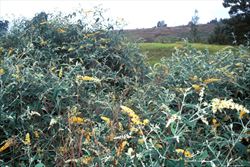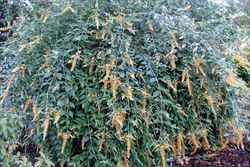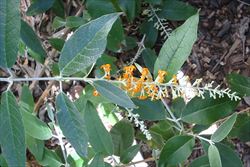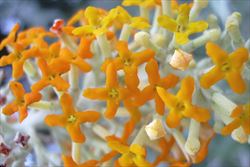Click on images to enlarge

infestation (Photo: Forest and Kim Starr, USGS)

habit as a sprawling shrub (Photo: Sheldon Navie)

habit as a climber (Photo: Sheldon Navie)

paired leaves (Photo: Sheldon Navie)

stems and leaf undersides (Photo: Sheldon Navie)

elongated flower cluster (Photo: Sheldon Navie)

flowers (Photo: Forest and Kim Starr, USGS)

close-up of flowers (Photo: Forest and Kim Starr, USGS)

clusters of immature and mature fruit (Photo: Forest and Kim Starr, USGS)

close-up of fruit (Photo: Forest and Kim Starr, USGS)

climbing habit (Photo: Sheldon Navie)

close-up of whitish hairy stems and leaf stalks (Photo: Sheldon Navie)
Scientific Name
Buddleja madagascariensis Lam.
Synonyms
Nicodemia madagascariensis (Lam.) R. Parker
Family
Buddlejaceae
Common Names
buddleia, buddleja bush, butterfly bush, butterflybush, Madagascar butterflybush, orange buddleia, smoke bush, smokebush
Origin
Native to Madagascar.
Cultivation
Widely cultivated as a garden ornamental, particularly in southern and eastern Australia.
Naturalised Distribution
Naturalised in many parts of eastern and southern Australia (i.e. in the coastal districts of south-eastern, central and northern Queensland, near Perth in south-western Western Australia, in the coastal districts of New South Wales and in south-eastern South Australia). Also naturalised on Lord Howe Island.
Naturalised overseas in many parts of tropical and subtropical Asia (e.g. China) as well as in New Zealand, south-eastern USA (i.e. Florida), Hawaii and New Caledonia.
Habitat
A weed of warmer temperate, sub-tropical and tropical regions in habitats where water and good drainage are available (e.g. roadsides, disturbed sites, waste areas, urban bushland, riparian zones, and forest margins).
Habit
An evergreen shrub with straggling or climbing branches usually growing 1.5-4 m tall, but occasionally reaching up to 10 m in height.
Distinguishing Features
- a straggling or climbing shrub usually growing up to 4 m tall.
- its older branches are woody and its younger branches are densely covered in whitish or yellowish hairs.
- its oppositely arranged leaves have greyish-green upper surfaces and very densely hairy white or yellowish undersides.
- its small, dark yellow or orange, tubular flowers are borne in elongated clusters at the tips of the branches.
- its small rounded berries (2.5-5 mm across) turn dark blue or purplish as they mature.
Stems and Leaves
The young branchlets are covered with densely matted whitish or yellowish hairs (i.e. they are tomentose).
The oppositely arranged leaves (2-15 cm long and 1.5-7 cm wide) are borne on stalks (i.e. petioles) 15-25 mm long. The leaf blades are narrowly egg-shaped in outline (i.e. narrowly-ovate) or narrowly oval (i.e. narrowly-elliptic) in shape with entire margins. They come to a point at the tip (i.e. have acute apices) and have a rounded (i.e obtuse) or slightly heart-shaped (i.e. sub-cordate) bases. The underside of the leaves is very densely covered with small, white to yellowish hairs (i.e. tomentose) while the upper leaf surface is dark green or greyish-green and hairless (i.e. glabrous).
Flowers and Fruit
The small tubular flowers (10-13 mm long) are dark yellow, orange or salmon pink in colour and sweetly scented. They are arranged in elongated clusters that may be branched or un-branched (i.e. in racemes or thyrsoid cymes). These clusters are borne at the tips of the branches and are 5-25 cm long. The stalkless (i.e. sessile) or shortly stalked (i.e. sub-sessile) flowers have four petals that are fused for most of their length into a tube (i.e. corolla tube) 7-10 mm long. The four spreading petal lobes (i.e. corolla lobes) are 2-4 mm long and the flowers also have four small green sepals (2-3.5 mm long) that are also fused together (i.e. into a calyx tube) for most of their length. Each flower also has four stamens and an ovary topped with a style and a club-shaped (i.e. clavate) stigma. Flowering occurs mostly during spring and summer, but flowers can be present throughout the year.
The fruit are rounded or oblong berries (2.5-5 mm across) containing many small seeds. These fruit turn from whitish in colour to dark bluish, purplish or violet as they mature. The seeds are oval (i.e. ellipsoid) in shape and about 1 mm long by 0.5 mm wide.
Reproduction and Dispersal
This species reproduces mainly by seed, but can also spread vegetatively via stem fragments. The seeds are most commonly dispersed by birds and other animals that eat the fleshy fruit. Stem segments and seeds can also be dispersed in dumped garden waste.
Environmental Impact
Orange buddleia (Buddleja madagascariensis) is regarded as an environmental weed in Queensland, New South Wales, South Australia and Western Australia. It is currently of most concern in south-eastern Queensland and north-eastern New South Wales. In south-eastern Queensland it is thought to be among the top 200 most invasive plant species, and it also recently appeared quite prominently on a list of the most important environmental weeds of the New South Wales North Coast region. It is also known to have spread into conservation areas in south-western Western Australia (e.g. Kings Park in Perth) and South Australia (i.e. Belair National Park and Cleland Conservation Park).
In warmer climates in Hawaii it is rampant and invasive, particularly as an early invader of heavily disturbed areas. Its rapid growth rate enables it to overtop slower growing native species and it develops into large spreading thickets that compete with other vegetation.
Legislation
Not declared or considered noxious by any state government authorities.
Similar Species
Orange buddleia (Buddleja madagascariensis) is similar to several other buddleias (Buddleja spp.) that have also recently become naturalised in Australia. These include climbing white sage (Buddleja dysophylla), orange ball tree (Buddleja globosa), Lindley's butterfly bush (Buddleja lindleyana) and butterfly bush (Buddleja davidii). These species cn be distinguished by the following differences:
- orange buddleia (Buddleja madagascariensis) is a straggling or climbing shrub with elongated (i.e. narrowly ovate) leaves 2-15 cm long. Its orange or yellow flowers are borne in dense elongated up to 25 cm long. Unlike the other species, its fruit is a globular blue or black berry (2.5-5 mm across).
- butterfly bush (Buddleja davidii) is an upright or arching shrub with elongated (i.e. narrowly ovate) leaves 4-20 cm long. Its mauve or purple (occasionally white) flowers have a orange-yellow throat and are borne in dense elongated clusters 12-30 cm long. Its fruit is a narrow brown capsule (5-10 mm long) that splits open when mature.
- climbing white sage (Buddleja dysophylla) is a sprawling or climbing shrub with triangular or heart-shaped (i.e. cordate) leaves 1-10 cm long. Its white or greenish-yellow flowers have a reddish-maroon throat and are borne in elongated clusters up to 30 cm long. Its fruit is a very small capsule (2-3.5 mm long) that splits open when mature.
- orange ball tree (Buddleja globosa) is an upright or arching shrub with elongated (i.e. narrowly ovate) leaves up to 20 cm long. Its yellow or orange flowers are borne in small rounded clusters about 2 cm across. Its fruit is a capsule that splits open when mature.
- Lindley's butterfly bush (Buddleja lindleyana) is an upright or arching shrub with elongated (i.e. narrowly ovate) leaves 3-11 long. Its purple flowers are borne in relatively loose elongated clusters 4-20 cm long. Its fruit is a short oval capsule (4-6 mm long) that splits open when mature.

